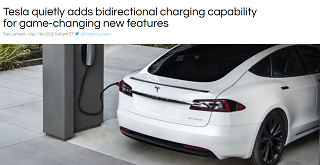Tesla’s Move Will Accelerate Vehicle to Grid Adoption

A study showed that electric vehicle fleets could save billions of dollars with controllable load and vehicle-to-grid features; this would also enable the grid to optimize its use of renewable energy.
It’s also possible, of course, to use this capacity as its own peaker plant, pulling a significant amount of energy from idle EVs rather than turning on gas plants.
Since the 1990s, however, V2G has gone quietly nowhere. During the last two decades, people have worked out the protocols, i.e., the “handshake” between an EV and grid operators that will enable all this to work, but very little has been done in terms of implementation.
Until now. It seems Tesla, without any fanfare, has integrated this capability into each of the Model 3 and Y they build and sell. This could turn around very quickly at this point.
